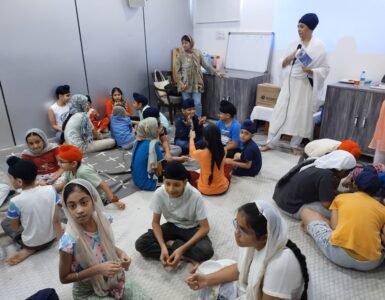The Early Days
Guru Hargobind Sahib Ji the Sixth Master of Sikhs, the son of Mata Ganga and Guru Arjan Dev, was born in 1595 in village Wadali of Amritsar district.
Baba Buddha Ji, a renowned Divine person, who originally was the disciple of Sri Guru Nanak Dev Ji, was entrusted with the responsibility of educating the divine child as well as training him in the use of arms.
Under the guidance of Baba Buddha Ji, Hargobind Sahib ji learned the lessons of performing the worldly as well as spiritual duties as per prevailing tradition.
The foundation of Miri and Piri
Abiding by the wishes of Sri Guru Arjan Dev Ji, Baba Buddha Ji, applied the frontal mark (Tilak) of Guruship on the forehead of the 11-year-old Hargobind in 1606. He adorned two swords around his neck, one towards the right side and the other towards the left, which symbolized the combination of worldly and spiritual affairs.
After the martyrdom of Guru Arjan Dev Ji, the followers of the Guru Ji submitted that the Mughal kingdom had developed enmity against the Sikhs and they could expect any type of suppression and that they should do something for self-protection against the invasion of these disoriented cruel rulers. Perceiving the prevailing circumstances, Guru Hargobind Sahib Ji asked the Sikhs to develop physical strength and martial arts for defence. He conveyed to his followers (Sikhs) that henceforth, besides offering money for community affairs, they should also offer horses, arms, and other combat material for self-defense.
The Fortification of Amritsar and ensuing battles
He fortified the town of Amritsar and built a small fort called Lohgarh near its outskirts to secure it against enemy attacks. In 1609, he built the Akal Takht, earlier called Akal Bunga, where Sikhs gathered to discuss spiritual and worldly affairs.
After Jehangir’s death, Shah Jahan ascended the Mughal throne. He pursued a much harsher policy against the Sikhs. To protect the rights of the poor and the downtrodden, Guru Hargobind fought four battles against the Mughals. He won all those battles but did not seize even a square inch of land to establish His own rule. It is thus apparent that Guru Hargobind waged only a divine crusade (Dharamyudh) for the righteous cause, which was grossly exploited and neglected by the previous rulers’ selfish motives.
Spreading the message of Divine Truth
After the last battle, Guru Hargobind settled down at Kiratpur on the banks of the river Sutlej. From there, He traveled far and wide, preaching the message of Divine Truth. Journeying to Kashmir, Nanakana Sahib, Pilibhit and the Malwa region, He preached the message of Sri Guru Nanak Dev Ji.
Baba Buddha Ji’s farewell
On the demise of Baba Buddha Ji at Ramdas in Amritsar, Guru Hargobind Sahib Ji performed the last rites. It is a unique case, which has no parallel in history that the most revered Gursikh of Guru Nanak Dev, being a completely divine person (Brahmgyani)never aspired to become the Guru. Whereas it was he, who formally anointed all the succeeding Gurus till Guru Hargobind Sahib Ji by putting the frontal mark on the forehead of all the Gurus during his life-span.
Citations:
Source: Sikh Faith – An Epitome of Inter-Faith for Divine Realisation, written By Shiromani Panth Ratan Baba Iqbal Singh Ji.














Add comment